ABS HONDA CIVIC HYBRID 2014 9.G Owners Manual
[x] Cancel search | Manufacturer: HONDA, Model Year: 2014, Model line: CIVIC HYBRID, Model: HONDA CIVIC HYBRID 2014 9.GPages: 377, PDF Size: 17.8 MB
Page 14 of 377
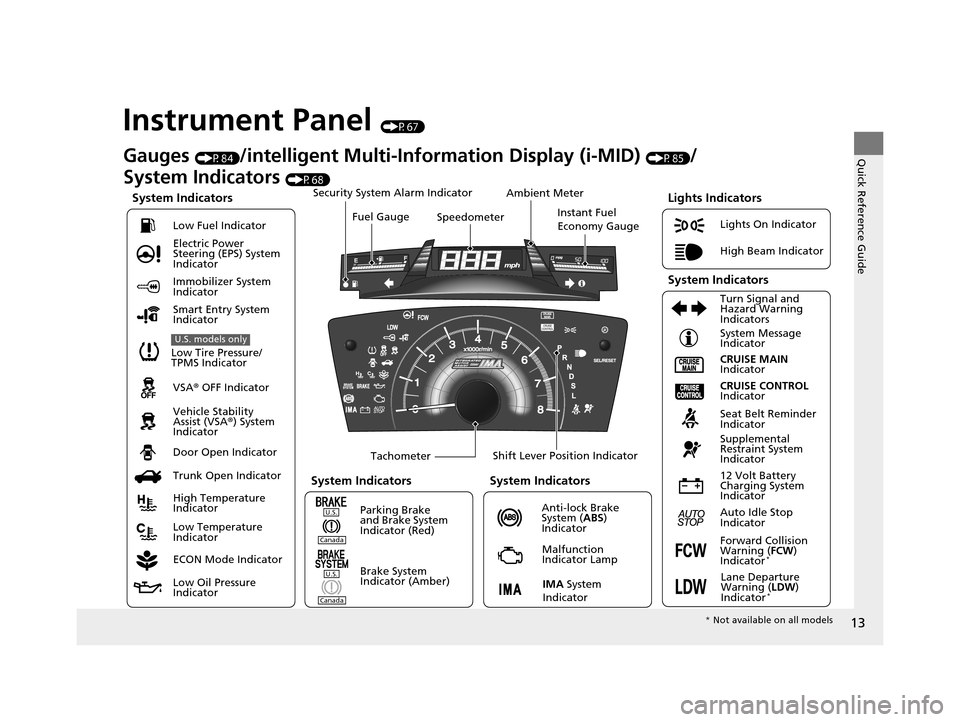
13
Quick Reference Guide
Instrument Panel (P67)
System Indicators
Malfunction
Indicator Lamp
Low Oil Pressure
Indicator Anti-lock Brake
System (
ABS)
Indicator
Vehicle Stability
Assist (VSA
®) System
Indicator VSA ® OFF Indicator
Electric Power
Steering (EPS) System
Indicator
Lights On Indicator
High Beam Indicator
Smart Entry System
Indicator
Seat Belt Reminder
Indicator
Lights Indicators
CRUISE MAIN
Indicator System Message
Indicator
Brake System
Indicator (Amber) Supplemental
Restraint System
Indicator
Forward Collision
Warning (
FCW)
Indicator
*
Door Open Indicator TachometerInstant Fuel
Economy Gauge
Speedometer
Fuel Gauge
Security System Alarm Indicator
Shift Lever Position Indicator
Low Fuel Indicator
Gauges (P84)/intelligent Multi-Info
rmation Display (i-MID) (P85)/
System Indicators
(P68)
Trunk Open Indicator
ECON Mode Indicator Turn Signal and
Hazard Warning
Indicators
High Temperature
Indicator
Low Temperature
Indicator Ambient Meter
System Indicators
System Indicators
Low Tire Pressure/
TPMS Indicator
U.S. models only
Parking Brake
and Brake System
Indicator (Red)
IMA System
Indicator
CRUISE CONTROL
Indicator
System Indicators
12 Volt Battery
Charging System
Indicator
Auto Idle Stop
Indicator
U.S.
Canada
U.S.
Canada
Lane Departure
Warning ( LDW)
Indicator
*
Immobilizer System
Indicator
* Not available on all models
14 CIVIC IMA-31TR26200.book 13 ページ 2013年12月23日 月曜日 午後4時9分
Page 23 of 377
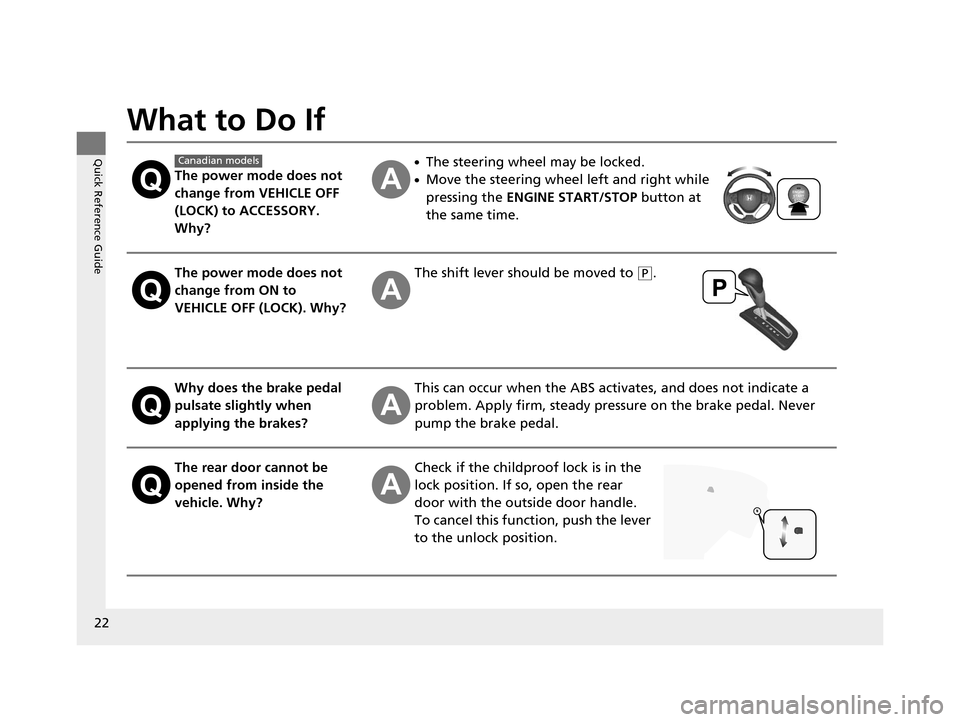
22
Quick Reference Guide
What to Do If
The power mode does not
change from VEHICLE OFF
(LOCK) to ACCESSORY.
Why?
●The steering wheel may be locked.
●Move the steering wheel left and right while
pressing the ENGINE START/STOP button at
the same time.
The power mode does not
change from ON to
VEHICLE OFF (LOCK). Why?The shift lever should be moved to (P.
Why does the brake pedal
pulsate slightly when
applying the brakes?This can occur when the ABS activates, and does not indicate a
problem. Apply firm, steady pressure on the brake pedal. Never
pump the brake pedal.
The rear door cannot be
opened from inside the
vehicle. Why?Check if the childproof lock is in the
lock position. If so, open the rear
door with the outside door handle.
To cancel this function, push the lever
to the unlock position.
Canadian models
14 CIVIC IMA-31TR26200.book 22 ページ 2013年12月23日 月曜日 午後4時9分
Page 45 of 377
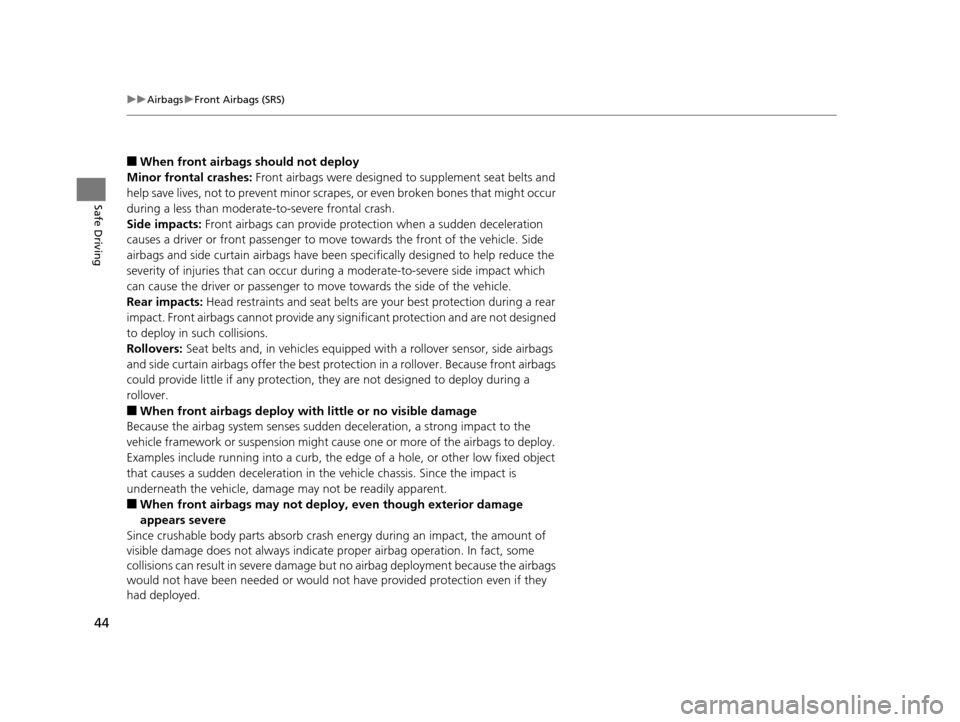
44
uuAirbags uFront Airbags (SRS)
Safe Driving
■When front airbags should not deploy
Minor frontal crashes: Front airbags were designed to supplement seat belts and
help save lives, not to prevent minor scrapes, or even broken bones that might occur
during a less than moderate-to-severe frontal crash.
Side impacts: Front airbags can provide protection when a sudden deceleration
causes a driver or front passenger to move towards the front of the vehicle. Side
airbags and side curtain airb ags have been specifically designed to help reduce the
severity of injuries that can occur during a moderate-to-severe side impact which
can cause the driver or passenger to move towards the side of the vehicle.
Rear impacts: Head restraints and seat belts are your best protection during a rear
impact. Front airbags cannot provide any significant protection and are not designed
to deploy in such collisions.
Rollovers: Seat belts and, in vehicl es equipped with a rollover sensor, side airbags
and side curtain airbags offer the best prot ection in a rollover. Because front airbags
could provide little if any protection, they are not designed to deploy during a
rollover.
■When front airbags deploy with little or no visible damage
Because the airbag system senses sudden deceleration, a strong impact to the
vehicle framework or suspension might caus e one or more of the airbags to deploy.
Examples include running into a curb, the edge of a hole, or other low fixed object
that causes a sudden deceleration in th e vehicle chassis. Since the impact is
underneath the vehicle, damage may not be readily apparent.
■When front airbags may not deploy, even though exterior damage
appears severe
Since crushable body parts absorb crash energy during an impact, the amount of
visible damage does not always indicate proper airbag operation. In fact, some
collisions can result in severe damage but no airbag deployment because the airbags
would not have been needed or would not have provided protection even if they
had deployed.
14 CIVIC IMA-31TR26200.book 44 ページ 2013年12月23日 月曜日 午後4時9分
Page 48 of 377
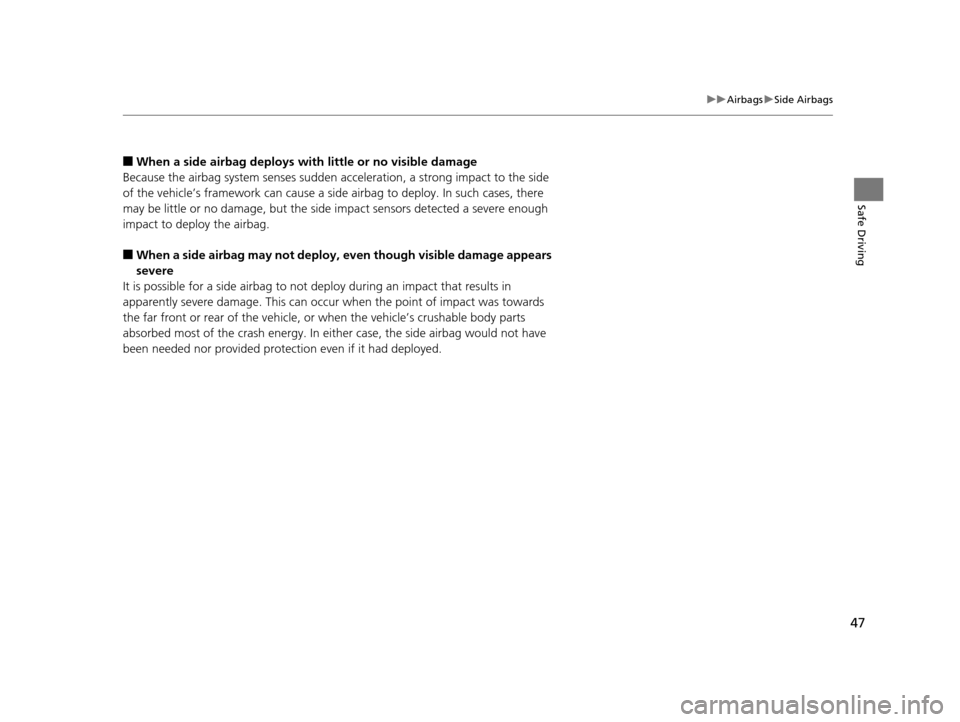
47
uuAirbags uSide Airbags
Safe Driving
■When a side airbag deploys with little or no visible damage
Because the airbag system senses sudden acceleration, a strong impact to the side
of the vehicle’s framework can cause a side airbag to deploy. In such cases, there
may be little or no damage, but the side impact sensors detected a severe enough
impact to deploy the airbag.
■When a side airbag may not deploy, even though visible damage appears
severe
It is possible for a side airbag to not deploy during an impact that results in
apparently severe damage. This can occu r when the point of impact was towards
the far front or rear of the vehicle, or when the vehicle’s crushable body parts
absorbed most of the crash energy. In either case, the side airbag would not have
been needed nor provided protec tion even if it had deployed.
14 CIVIC IMA-31TR26200.book 47 ページ 2013年12月23日 月曜日 午後4時9分
Page 69 of 377
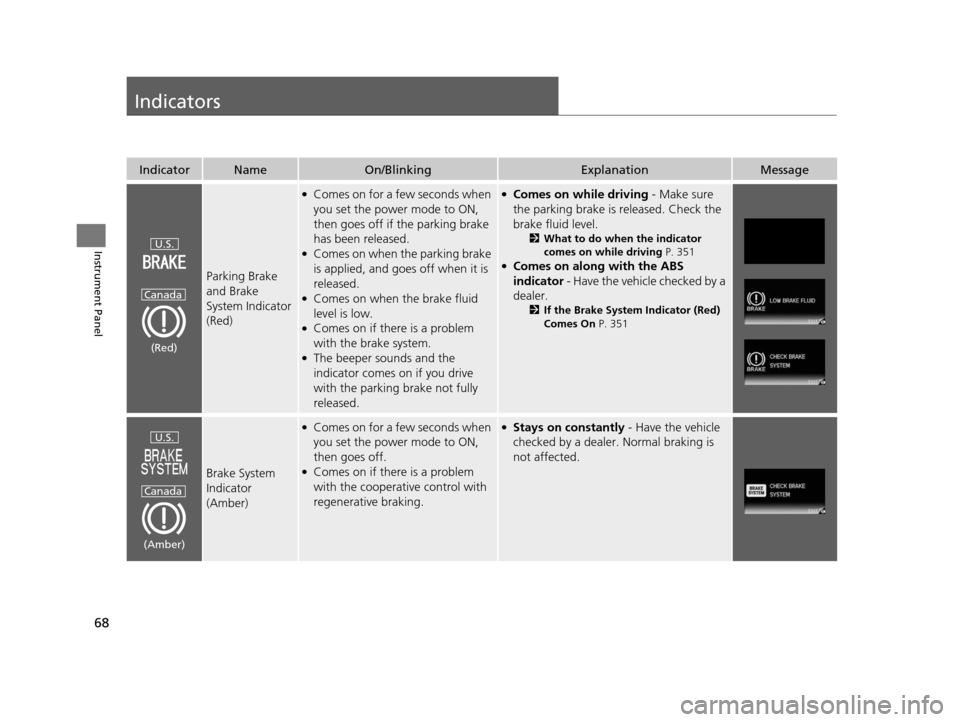
68
Instrument Panel
Indicators
IndicatorNameOn/BlinkingExplanationMessage
Parking Brake
and Brake
System Indicator
(Red)
●Comes on for a few seconds when
you set the power mode to ON,
then goes off if the parking brake
has been released.
●Comes on when the parking brake
is applied, and goes off when it is
released.
●Comes on when the brake fluid
level is low.
●Comes on if there is a problem
with the brake system.
●The beeper sounds and the
indicator comes on if you drive
with the parking brake not fully
released.
●Comes on while driving - Make sure
the parking brake is released. Check the
brake fluid level.
2 What to do when the indicator
comes on while driving P. 351
●Comes on along with the ABS
indicator - Have the vehicle checked by a
dealer.
2 If the Brake System Indicator (Red)
Comes On P. 351
Brake System
Indicator
(Amber)
●Comes on for a fe w seconds when
you set the power mode to ON,
then goes off.
●Comes on if there is a problem
with the cooperative control with
regenerative braking.
●Stays on constantly - Have the vehicle
checked by a dealer. Normal braking is
not affected.
U.S.
Canada
(Red)
U.S.
Canada
(Amber)
14 CIVIC IMA-31TR26200.book 68 ページ 2013年12月23日 月曜日 午後4時9分
Page 72 of 377
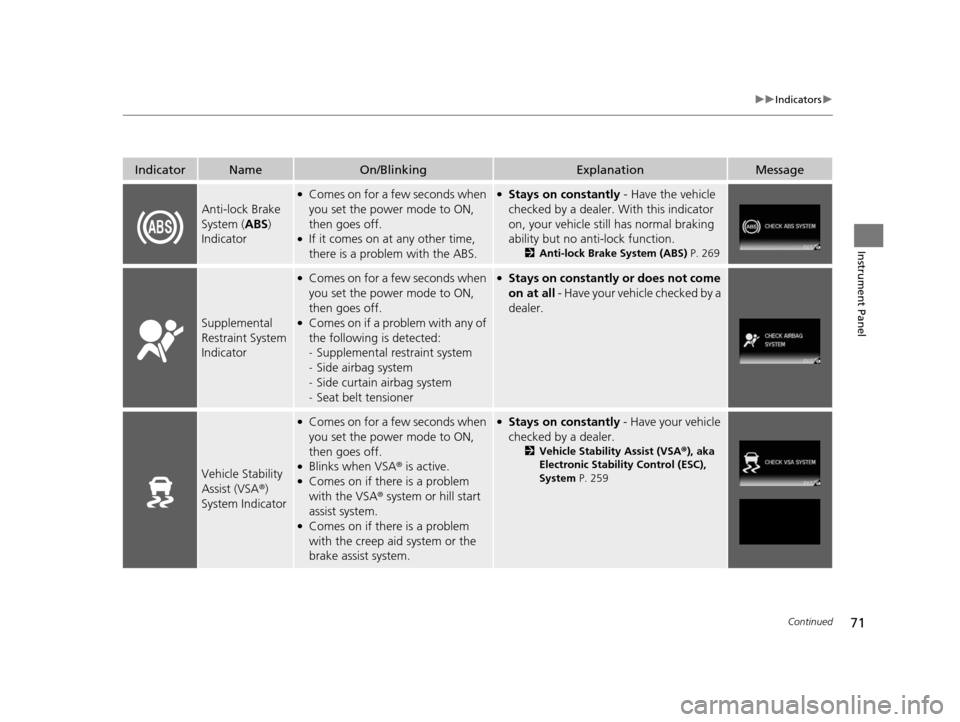
71
uuIndicators u
Continued
Instrument Panel
Anti-lock Brake
System (ABS)
Indicator
●Comes on for a few seconds when
you set the power mode to ON,
then goes off.
●If it comes on at any other time,
there is a problem with the ABS.
●Stays on constantly - Have the vehicle
checked by a dealer. With this indicator
on, your vehicle still has normal braking
ability but no anti-lock function.
2 Anti-lock Brake System (ABS) P. 269
Supplemental
Restraint System
Indicator
●Comes on for a few seconds when
you set the power mode to ON,
then goes off.
●Comes on if a problem with any of
the following is detected:
-Supplemental restraint system
- Side airbag system
- Side curtain airbag system
- Seat belt tensioner
●Stays on constantly or does not come
on at all - Have your vehicle checked by a
dealer.
Vehicle Stability
Assist (VSA ®)
System Indicator
●Comes on for a few seconds when
you set the power mode to ON,
then goes off.
●Blinks when VSA ® is active.●Comes on if there is a problem
with the VSA® system or hill start
assist system.
●Comes on if there is a problem
with the creep aid system or the
brake assist system.
●Stays on constantly - Have your vehicle
checked by a dealer.
2 Vehicle Stability Assist (VSA ®), aka
Electronic Stability Control (ESC),
System P. 259
IndicatorNameOn/BlinkingExplanationMessage
14 CIVIC IMA-31TR26200.book 71 ページ 2013年12月23日 月曜日 午後4時9分
Page 160 of 377
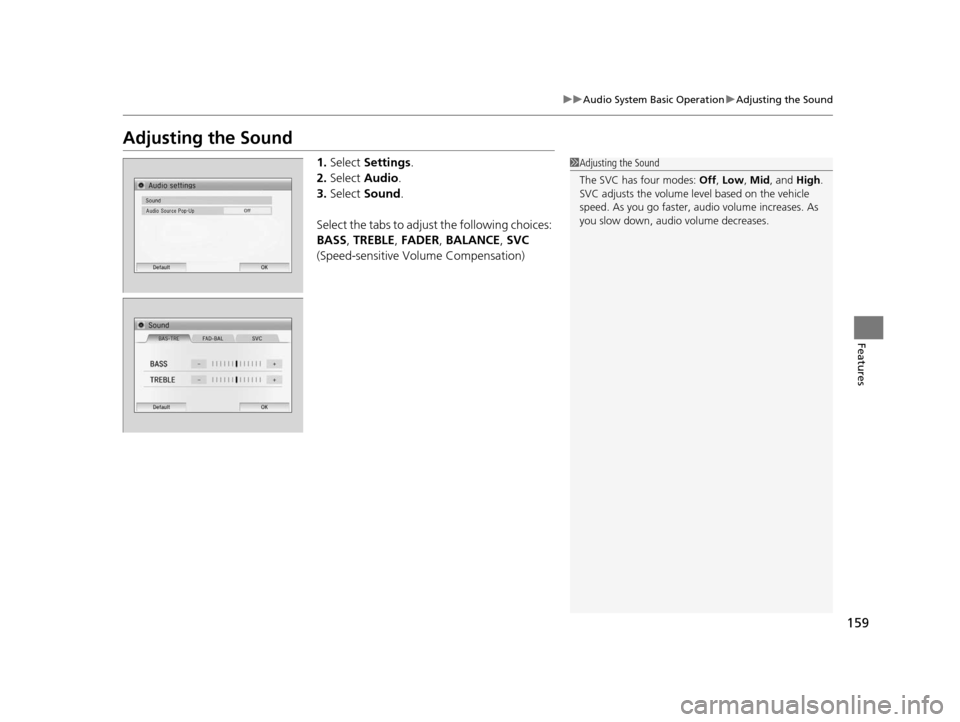
159
uuAudio System Basic Operation uAdjusting the Sound
Features
Adjusting the Sound
1. Select Settings .
2. Select Audio .
3. Select Sound .
Select the tabs to adjust the following choices:
BASS , TREBLE , FADER , BALANCE , SVC
(Speed-sensitive Vo lume Compensation)1Adjusting the Sound
The SVC has four modes: Off, Low , Mid, and High.
SVC adjusts the volume level based on the vehicle
speed. As you go faster, audio volume increases. As
you slow down, audi o volume decreases.
14 CIVIC IMA-31TR26200.book 159 ページ 2013年12月23日 月曜日 午後4時9分
Page 232 of 377
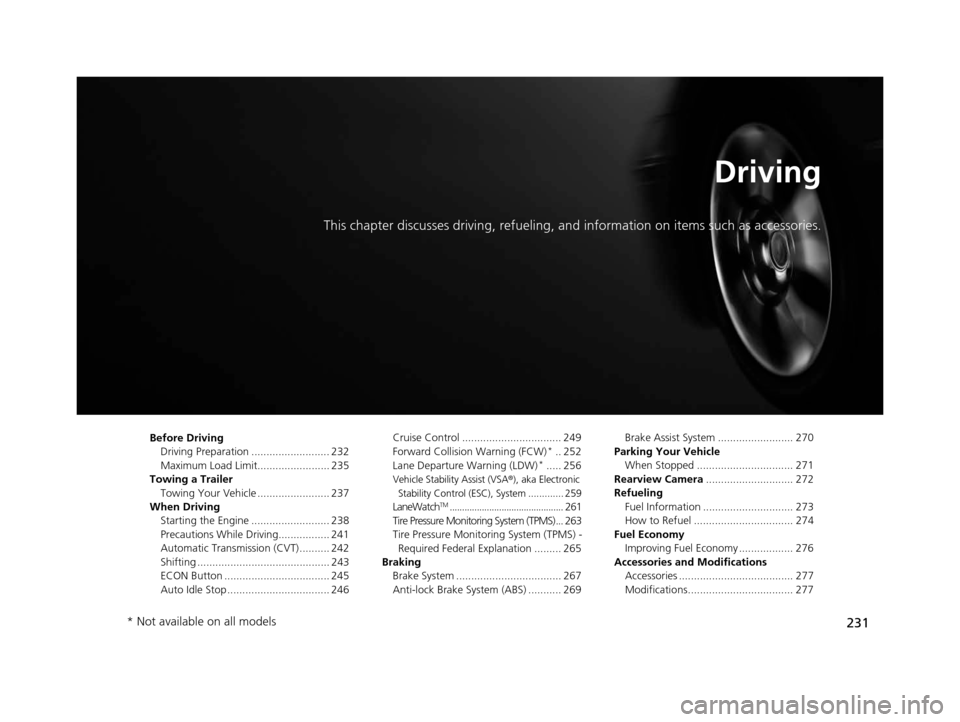
231
Driving
This chapter discusses driving, refueling, and information on items such as accessories.
Before Driving
Driving Preparation .......................... 232
Maximum Load Limit........................ 235
Towing a Trailer Towing Your Vehicle ........................ 237
When Driving Starting the Engine .......................... 238
Precautions While Driving................. 241
Automatic Transmission (CVT) .......... 242
Shifting ............................................ 243
ECON Button ................................... 245
Auto Idle Stop .................................. 246 Cruise Control ................................. 249
Forward Collision Warning (FCW)*.. 252
Lane Departure Warning (LDW)*..... 256
Vehicle Stability Assist (VSA ®), aka Electronic
Stability Control (ESC), System ............. 259
LaneWatchTM.............................................. 261
Tire Pressure Monitori ng System (TPMS) ... 263
Tire Pressure Monitoring System (TPMS) - Required Federal Explanation ......... 265
Braking Brake System ................................... 267
Anti-lock Brake System (ABS) ........... 269 Brake Assist System ......................... 270
Parking Your Vehicle When Stopped ................................ 271
Rearview Camera ............................. 272
Refueling Fuel Information .............................. 273
How to Refuel ................................. 274
Fuel Economy Improving Fuel Economy .................. 276
Accessories and Modifications Accessories ...................................... 277
Modifications................................... 277
* Not available on all models
14 CIVIC IMA-31TR26200.book 231 ページ 2013年12月23日 月曜日 午後4時9分
Page 269 of 377
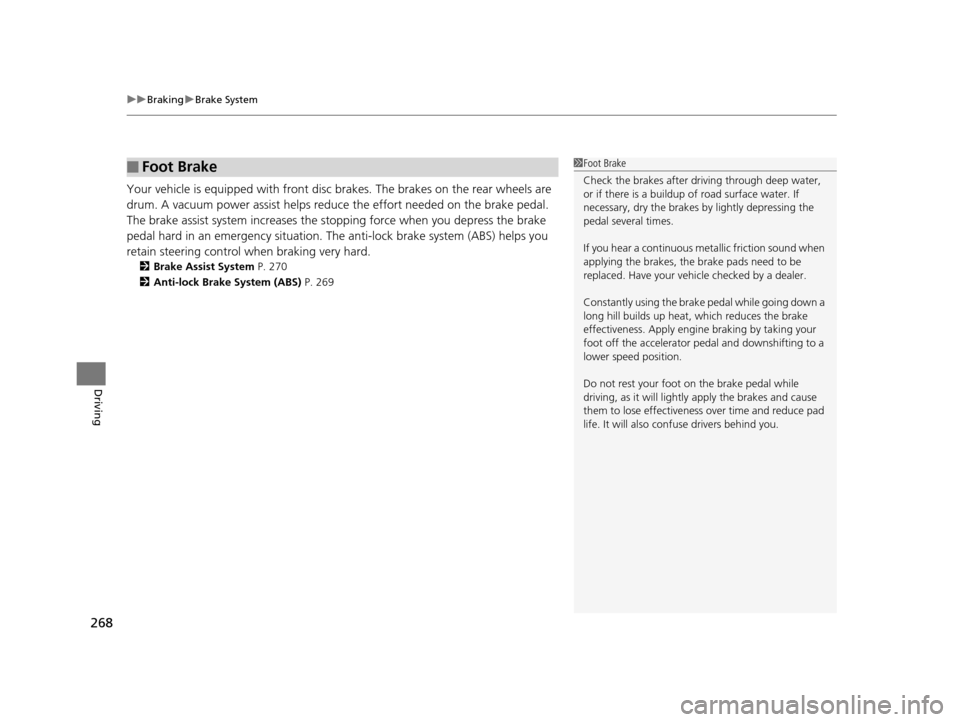
uuBraking uBrake System
268
Driving
Your vehicle is equipped with front disc brakes. The brakes on the rear wheels are
drum. A vacuum power assist helps reduce the effort needed on the brake pedal.
The brake assist system increases the st opping force when you depress the brake
pedal hard in an emergenc y situation. The anti-lock brake system (ABS) helps you
retain steering control when braking very hard.
2 Brake Assist System P. 270
2 Anti-lock Brake System (ABS) P. 269
■Foot Brake1Foot Brake
Check the brakes after driving through deep water,
or if there is a buildup of road surface water. If
necessary, dry the brakes by lightly depressing the
pedal several times.
If you hear a continuous me tallic friction sound when
applying the brakes, the brake pads need to be
replaced. Have your vehi cle checked by a dealer.
Constantly using the brak e pedal while going down a
long hill builds up heat, which reduces the brake
effectiveness. Apply engine braking by taking your
foot off the accelerator pe dal and downshifting to a
lower speed position.
Do not rest your foot on the brake pedal while
driving, as it will lightly apply the brakes and cause
them to lose effectiveness over time and reduce pad
life. It will also conf use drivers behind you.
14 CIVIC IMA-31TR26200.book 268 ページ 2013年12月23日 月曜日 午後4時9分
Page 270 of 377
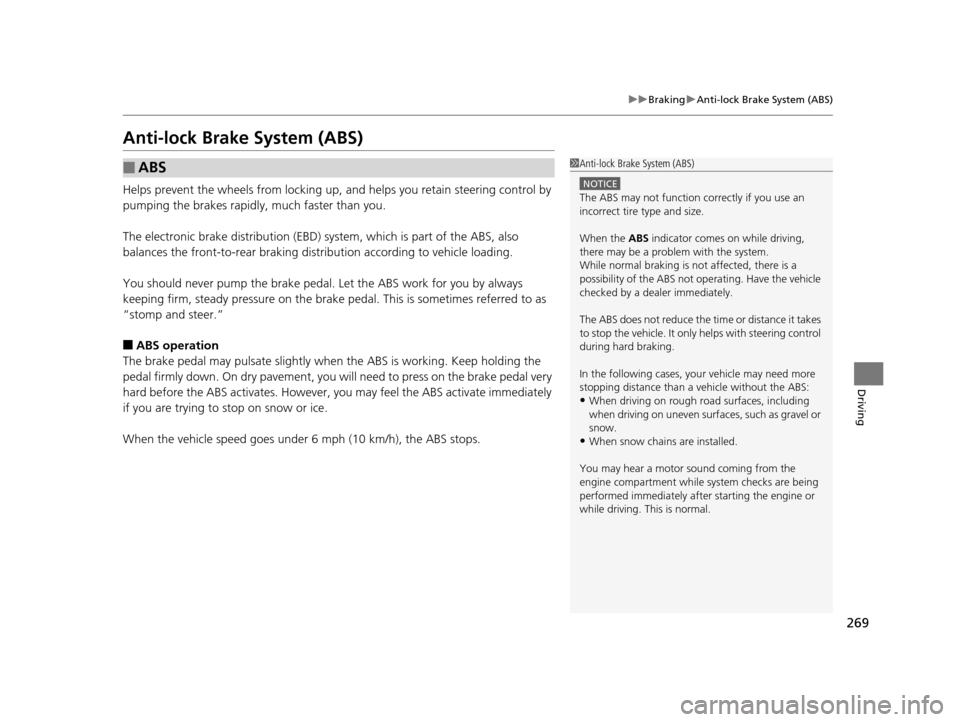
269
uuBraking uAnti-lock Brake System (ABS)
Driving
Anti-lock Brake System (ABS)
Helps prevent the wheels from locking up, and helps you retain steering control by
pumping the brakes rapidly, much faster than you.
The electronic brake distribu tion (EBD) system, which is part of the ABS, also
balances the front-to-rear braking distribution according to vehicle loading.
You should never pump the brake pedal. Let the ABS work for you by always
keeping firm, steady pressure on the brake pe dal. This is sometimes referred to as
“stomp and steer.”
■ABS operation
The brake pedal may pulsate slightly when the ABS is working. Keep holding the
pedal firmly down. On dry pavement, you will need to press on the brake pedal very
hard before the ABS activates. However, you may feel the ABS activate immediately
if you are trying to stop on snow or ice.
When the vehicle speed goes under 6 mph (10 km/h), the ABS stops.
■ABS1Anti-lock Brake System (ABS)
NOTICE
The ABS may not function correctly if you use an
incorrect tire type and size.
When the ABS indicator comes on while driving,
there may be a problem with the system.
While normal braking is not affected, there is a
possibility of the ABS not operating. Have the vehicle
checked by a dealer immediately.
The ABS does not reduce the ti me or distance it takes
to stop the vehicle. It only helps with steering control
during hard braking.
In the following cases, yo ur vehicle may need more
stopping distance than a vehicle without the ABS:
•When driving on rough road surfaces, including
when driving on uneven surf aces, such as gravel or
snow.
•When snow chains are installed.
You may hear a motor sound coming from the
engine compartment while system checks are being
performed immediately after starting the engine or
while driving. This is normal.
14 CIVIC IMA-31TR26200.book 269 ページ 2013年12月23日 月曜日 午後4時9分